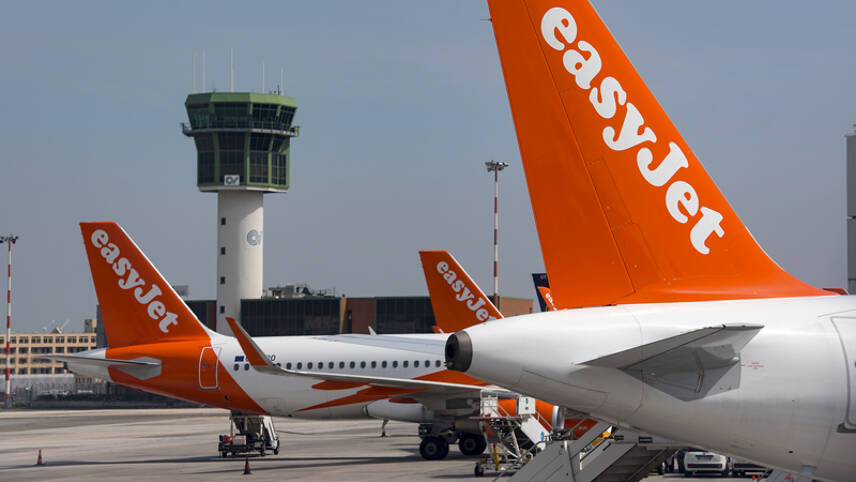Register for free and continue reading
Join our growing army of changemakers and get unlimited access to our premium content

easyJet has 2030 emissions goals that are SBTi-verified in line with 2C and is seeking to build on them
The airline unveiled a new roadmap for reaching net-zero on Monday (26 September) after previously stating an intention to reach net-zero by 2050.
It claims that the measures detailed would enable the carbon intensity of flights to be 78% lower in 2050 than they were in 2019, on a per-passenger, per-kilometre business. It bears noting that the SBTi usually requires businesses to pledge to reduce absolute emissions by at least 90% by 2050 for net-zero verification.
easyJet’s new plans rely predominantly on the introduction of more efficient aircraft and processes, the adoption of sustainable aviation fuels (SAFs) and the use of hydrogen aircraft.
Hydrogen is positioned as the predominant solution in the long term. easyJet has stated that while it is “looking at all options for zero carbon emission flight”, “based on today’s technological advances, hydrogen shows the most potential for a short-haul airline like easyJet to truly decarbonise”.
Hydrogen aircraft of the size usually used by airlines are not yet commercially available, so the airline has partnered with Rolls-Royce to accelerate development. It has stated that it will adopt the technology “once available”. easyJet is also collaborating with Airbus, GKN Aerospace, Wright Electric and Cranfield Aerospace Solutions on hydrogen aircraft.
In the meantime, easyJet will invest in new, more efficient aircraft. It has opted to purchase 168 Airbus NEO aircraft, which are at least 15% more fuel-efficient than the aircraft they will replace. It will also improve operational efficiencies using digital technologies that can improve air turbine performance and make navigation more efficient.
These new, efficient aircraft will fly using a blend of traditional jet fuel and SAFs. easyJet has stated that it will “use SAF as required, until its fleet has been transitioned to zero carbon emission aircraft”. It has been flying some of its Gatwick flights on a 30% SAF blend since last year and the provider of this SAF, Q8 Aviation, will provide more to easyJet in the coming years.
Offsetting changes
In a media event held to mark the launch of the new plan, easyJet confirmed that, once its three-year carbon offsetting contract comes to an end at the end of 2022, it will no longer pay for offsets as standard.
The Guardian has speculated that this decision may, in part, be down to an expose it published into the forest offsetting schemes used by airlines in May 2021. Conducted in partnership with Unearthed, the investigation found that such schemes were not always delivering additional carbon benefits.
easyJet’s new plan puts less emphasis on nature-based offsetting and more onus on man-made carbon removal technologies. The firm confirmed that it has signed a letter of intent with Airbus to support the development of direct air capture (DAC) and other carbon removal technologies.
Passengers flying with easyJet from January 2023 will be able to pay to offset the emissions related to their trip voluntarily. It has not yet been clarified whether the offsets will be from nature-based or man-made projects.
Man-made carbon dioxide removal technologies are in their commercial infancy. By the end of 2021, fewer than 10,000 tonnes of CO2 had been permanently sequestered using these technologies – equivalent to less than 1% of global emissions in 2021. While organisations including the Intergovernmental Panel on Climate Change (IPCC), Energy Transitions Commission and Centre for Climate Repair have concluded that carbon-negative technologies are needed to give humanity the best chance of delivering net-zero, there are significant risks that they will not commercially scale due to technological challenges, with many thought leaders warning nations and corporates against framing them as a silver bullet.


There is no such thing as “sustainable” biofuels. Producing the *incremental* power to generate hydrogen can only be done by burning more gas, generating more than 2x the emissions of the fossil fuels it replaces. This will remain true till all power generation is renewable or nuclear – well after 2030, and the moreH2/EVs/heatpumps demand more power, the later this point will be.
EDIE – please stop just broadcasting corporate propaganda without fact-checking it.
Absolutely true, the key sentence is “This will remain true till all power generation is renewable or nuclear”